Good-bye Plastic, Hello Phone: Mobile Wallets on the Rise

Forget about what's in your wallet. The real question is: will you even need a wallet?
The latest trend in credit card payment technology is the use of mobile wallets. This innovation eliminates the plastic and turns your phone into a digital payment portal. From MasterCard to PayPal, major payment processors are jumping on the bandwagon and offering their own mobile wallet apps.
Is this really the wave of the future? According to some indications, we may be heading toward not only a cashless society but a plastic-less one as well.
The rise of contactless payments
Remember the old days? When you had to swipe your credit card and then wait and wait for that little slip of paper to print so you could sign for your purchase?
Ok, so that is still the reality for many credit and debit transactions. However, credit card companies and retailers seem to be banking on consumers finding the swiping and signing process far too time-consuming and tedious. Instead, they see the future in contactless payments.
Contactless payments can trace their history back to 1997 when Mobil gas stations introduced the Speedpass. Using RFID (radio frequency identification) technology, the passes allowed customers to wave a key card in front of the pump to pay before filling up and heading on their way.
Then in 2004, MasterCard introduced PayPass which used the same technology. American Express jumped in with ExpressPay in 2005, and Visa followed suit in 2007 with its payWave option.
While RFID contactless options are still available, the advent of smart phones has led to the development of new mobile wallets that leave the card completely behind.
Payments go mobile
As an emerging trend, mobile wallets can be hard to pigeon-hole. However, the term is generally used to refer to the phenomenon of using mobile apps to load credit, debit and loyalty cards on your phone.
When it comes time to pay, retailers may scan a bar code on the phone, consumers may tap their device on a reader or they may do nothing at all as the register and phone communicate automatically using near field communication technology. Regardless of the method, consumers are often free to go their way without swiping a card, entering a PIN or signing a receipt.
According to a 2012 survey conducted by the Carlisle & Gallagher Consulting Group, 48% of respondents expressed interest in mobile wallet technology. Not surprisingly, younger consumers between the ages of 18-50 and those in households earning more than $50,000 a year were most interested in these mobile apps.
Mobile payments mean more money spent
Although mobile wallets haven't caught on to the same extent as, say, texting and tweeting, that hasn't stopped retailers and payment processors from seeing dollars signs when looking to the future.
Technology consulting firm Gartner was reported in CNN Money as estimating mobile payments will be a $617 billion market in 2016, compared to $171.5 billion in 2012. In addition to an overall increase in the amount of purchases being made via mobile payments, retailers can also look forward to more spending from consumers using contactless methods.
MasterCard Advisors discovered spending increased an average of 30% in the 12 months after an individual first used a contactless payment. For those in the highest spending category, that's $600 more a month that shifted to contectless payments.
Retailers and credit card companies compete for market share
Mobile wallets have attracted the attention of businesses large and small. Some retailers, such as Dunkin Donuts and Starbucks, have launched mobile wallet apps specifically for their stores. Others, including the Google Wallet app, allow users to load multiple credit cards that can be used at a variety of stores both online and in-person.
As competition for consumer dollars heats up, some big names have stepped in to the fray. Walmart, Target and 12 other retailers have joined forces to form the Merchant Customer Exchange which is developing a mobile wallet app for use at participating stores. Meanwhile, MasterCard has updated its PayPass program so consumers can bypass their credit card and pay with their phone instead.
Not wanting to be left behind, Discover has announced a partnership with PayPal that will allow members of the online payment service to make mobile wallet purchases at any of Discover's 7 million merchant partners. That's good news for the 80% of respondents in the Carlisle & Gallagher survey who said they would like use PayPal as their mobile wallet provider.
Consumer obstacles remain
As seems to be the case with all new technology, some have questions regarding mobile wallets and security and privacy issues. Mobile security firm Lookout estimates a smart phone was lost by its owner every 3.5 seconds in 2011. Lost devices with mobile wallets that are not password or PIN protected could end up costing their owner more than just the price of the phone.
In addition, while mobile wallets can be convenient, they are limited by the number of retailers who are equipped to accept payments via the near field communication technology used by many apps. For example, start-up Square offers the app Pay with Square, but the app is only compatible with 75,000 small merchants nationwide.
However, limited accessibility may be a thing of the past as major players like MasterCard begin to offer mobile wallets. In a New York Times article, Jennifer Miles of VeriFone, which provides merchant payment terminals, notes many businesses will likely be upgrading as they come under pressure from credit card companies.
Are mobile wallets here to stay? Retailers seem to think so.
The original article can be found at CardRatings.com:Good-bye plastic, hello phone: Mobile wallets on the rise